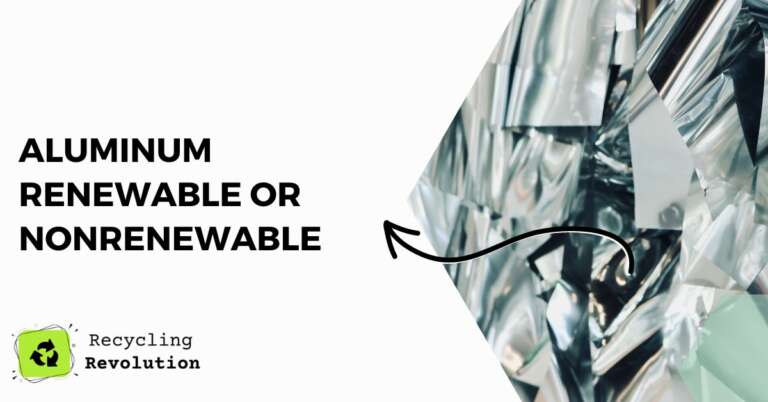Ah, aluminum! That shiny, lightweight, and incredibly versatile metal we encounter almost daily. From our soda cans to window frames, to airplane parts, it’s an integral part of our lives.
But have you ever stopped to ponder, in those quieter moments with a soda can in hand, whether aluminum is renewable or nonrenewable? It’s a pressing question in this age of sustainability, and today, we’re about to unwrap this metallic mystery.
♻️ Aluminum Recycling Estimator
🔍 Why Recycle Aluminum?
Aluminum is endlessly recyclable without quality loss. Found in soda cans, cars, bikes, laptops, and foil, recycling aluminum saves up to 95% of the energy used to make it from raw ore.
tl;dr: Aluminum, as an element, is nonrenewable because it’s naturally occurring and finite in supply. However, aluminum as a material is highly recyclable and can be reused almost indefinitely, making its life cycle appear more “renewable” than other materials.
The Origin Story: Where Does Aluminum Come From?
To truly understand the renewability of any resource, we must first trace its origins. Aluminum is the third most abundant element in the Earth’s crust, making up about 8% of its weight. Most of it is found in the form of bauxite ore, which is then processed to extract aluminum.
Note: Extracting aluminum from bauxite is an energy-intensive process that also creates significant greenhouse gas emissions.
A Matter of Semantics: Renewable vs. Recyclable
Now, if you’re a stickler for definitions like me, you’d know that for something to be truly renewable, it should be naturally replaced within a human timescale, like sunlight or wind. By this definition, aluminum (or any metal, for that matter) is nonrenewable. Once we’ve mined all the bauxite, that’s it; there’s no more left for our future soda can needs.
However, here’s where aluminum’s story gets fascinating. While the element itself is finite, aluminum as a material is almost infinitely recyclable. In fact, nearly 75% of all aluminum ever produced is still in use today, thanks to recycling.
I recommend not confusing the terms. Just remember: while aluminum isn’t renewable, it’s one of the most recyclable materials out there.
The Magic of Recycling: Giving Aluminum a Second Chance
When aluminum is recycled, it retains its properties. This means that an old soda can can become a new one without any loss in quality. What’s even better is that recycling aluminum uses only 5% of the energy required to produce the same amount from raw bauxite.
A study from the Environmental Protection Agency (EPA) highlighted that recycling aluminum can save up to 92% of the energy needed to produce it from raw materials. This means a huge potential for cutting down emissions and energy consumption if we up our recycling game.
Note: The rate of aluminum recycling can vary by country. Always check local guidelines and contribute to your community’s recycling efforts.
Looking to the Future: Aluminum’s Role in a Sustainable World
As we strive for a more sustainable future, the way we view and use resources like aluminum will need to evolve. With its high recyclability, aluminum offers an advantage over many other materials.
However, the challenge remains in ensuring that aluminum is sourced responsibly. Mining bauxite can have devastating effects on local ecosystems and communities. As consumers, I recommend supporting companies that commit to responsible sourcing and high recycling rates.
Moreover, the future might see breakthroughs in the way we extract aluminum, making it even more energy-efficient and reducing its environmental footprint.
Environmental Impacts of Aluminum Production
When discussing any material’s sustainability, it’s imperative to scrutinize its environmental footprint throughout its lifecycle. For aluminum, its story isn’t just about its impressive recyclability.
Mining Woes: The Bauxite Dilemma
Bauxite mining, the primary step to get our beloved aluminum, often has significant environmental impacts. These mining operations can:
- Destroy habitats and lead to deforestation.
- Pollute water sources, impacting both ecosystems and communities.
- Generate red mud, a toxic byproduct which can harm surrounding environments.
Note: The location of bauxite mines is also a critical factor. Some regions have regulations that enforce sustainable mining practices, while others may not be as stringent.
Emissions from Aluminum Production
The Hall-Héroult process, which is the primary method of extracting aluminum from bauxite, involves electrolysis and requires a lot of energy, typically derived from fossil fuels. Consequently:
- Greenhouse gas emissions from this process are substantial. This doesn’t only come from the energy use, but also from the release of perfluorocarbons (potent greenhouse gases) during the smelting process.
- Sulfur dioxide and nitrogen dioxide, both of which contribute to acid rain, can be byproducts.
I recommend always staying updated with the latest technological advancements. New methods that might reduce these emissions or even alternative ways of obtaining aluminum are being researched.
Economic Impacts of Aluminum
The global aluminum industry is not just about materials and emissions; it has significant socio-economic implications.
- Many communities around the world are heavily reliant on bauxite mining for their livelihoods.
- The aluminum industry provides jobs, infrastructure, and often essential services in areas where bauxite is mined.
However, there are challenges:
- Mining can lead to displacement of communities.
- There are often disputes over land rights, especially in regions where indigenous communities are present.
- The volatility of global aluminum prices can make economies dependent on bauxite mining vulnerable.
The Bright Side: Innovations in Aluminum Production
It’s not all doom and gloom! Innovations are being researched and developed to make the production of aluminum more sustainable.
- Carbon Capture in Aluminum Production: Companies are exploring ways to capture the CO2 emissions from the smelting process, significantly reducing its carbon footprint.
- Inert Anode Technology: Traditional smelting uses carbon anodes, which release CO2. Inert anodes, on the other hand, could produce oxygen, making the process cleaner.
- Direct Bauxite Electrolysis: Scientists are also exploring ways to extract aluminum directly from bauxite, bypassing the energy-intensive step of first refining it into alumina.
I recommend keeping a keen eye on these innovations. As technology advances, aluminum’s environmental footprint might reduce, further solidifying its place in a sustainable future.
Your Role in the Aluminum Life Cycle
Understanding aluminum’s journey helps us make informed decisions. While you might not be directly involved in its production:
- Opt for products made from recycled aluminum whenever possible.
- Make sure you’re recycling aluminum products correctly.
- Support and advocate for companies and policies that promote sustainable mining and production practices.
Every small step counts in our collective journey towards sustainability. While aluminum has its challenges, its potential for a more sustainable lifecycle is undeniable. And with continued focus and innovation, its story can only get shinier!
Conclusion
To sum it all up, aluminum as an element is definitively nonrenewable. We have a finite amount of bauxite ore on our planet, and once it’s gone, it’s gone. But in the grand scheme of things, the way we use aluminum makes it appear almost renewable.
Its high recyclability and long life cycle mean that, with responsible use and robust recycling systems, we can enjoy the benefits of aluminum with a reduced environmental impact.
FAQs
Is aluminum sustainable?
While aluminum is nonrenewable, its high recyclability makes it more sustainable than many other materials. Still, responsible sourcing and recycling are crucial.
How much energy is saved by recycling aluminum?
Recycling aluminum can save up to 92% of the energy needed to produce it from raw materials, according to the EPA.
What percentage of aluminum is recycled worldwide?
Nearly 75% of all aluminum ever produced is still in use today due to recycling.
Remember, every time you toss an aluminum can into the recycling bin, you’re not just disposing of waste. You’re giving that can a shot at a new life. Here’s to many more shiny, recycled lives for aluminum!

